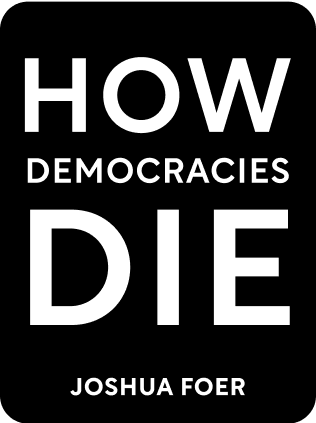

This article is an excerpt from the Shortform book guide to "How Democracies Die" by Steven Levitsky and Daniel Ziblatt. Shortform has the world's best summaries and analyses of books you should be reading.
Like this article? Sign up for a free trial here .
What does the future hold in store for the representative government in the United States? Do you think democracy will recover or will the country inevitably slide into authoritarianism?
According to Levitsky and Ziblatt, the authors of How Democracies Die, there are three possible scenarios for the future of democracy in the United States: 1) recovery, 2) authoritarian takeover, and 3) worsening party polarization.
In this article, we’ll explore what they believe might lie ahead for American democracy.
The Future of U.S. Democracy
Following their comparative historical analysis of democratic failure in an international context and their examination of the threats they believe to be confronting American democracy, Levitsky and Ziblatt chart three possible scenarios for the future of democracy in America:
- Democratic recovery
- Authoritarian takeover
- Worsening polarization
1. Democratic Recovery
In Levitsky and Ziblatt’s analysis, democratic recovery represents the most optimistic vision for American democracy. In this scenario, the Trump era proves to be short-lived, leaving behind few lasting effects. For example, he could lose his bid for reelection with Republicans suffering major electoral defeats at the federal, state, and local levels. Alternatively, he could be removed from office via impeachment or resignation.
As Levitsky and Ziblatt envision it, Trump would be swiftly replaced by new pro-democratic reforms that strengthen the republic. Future historians might look back on the Trump years as a brief aberration, a period during which America stared into the brink of authoritarianism and decided to step back.
However, the authors consider this scenario unlikely. They argue that the forces within the Republican Party that enabled Trump long preceded him—and they are likely to be in place long after he is gone from the political scene. In their ultimate analysis, Trump is more of a symptom than a cause of the current democratic crisis.
| Has American Democracy Recovered? Since the publication of How Democracies Die at the beginning of 2018, one could argue that the U.S. has witnessed many of the events Levitsky and Ziblatt would associate with democratic recovery—a scenario they rate as unlikely. The 2018 midterm elections delivered what political analysts called a “blue wave,” with Democrats picking up a net 41 seats in the House of Representatives and winning the House popular vote by nearly 10 million—the party’s best showing since 1974 and the largest congressional popular vote difference in American history. Following the Democratic takeover of the House, Trump was impeached twice (although not removed from office) and was defeated in the 2020 presidential election. If we accept Levitsky and Ziblatt’s analysis, this would seem to indicate a robust pushback by pro-democracy forces. |
2. Authoritarian Takeover
The next scenario presented by Levitsky and Ziblatt is what they see as the darkest. This is a world in which the Republican Party continues to score electoral success with its shrinking and increasingly radicalized white Christian base. They see the Republican Party using its majorities at the federal and state levels to rig the rules in its favor and reshape the courts, gerrymander the electorate, and systematically disempower non-whites through voter ID laws, mass deportations, and harsh immigration restrictions.
| The Ongoing Threat to U.S. Democracy There is some evidence to back up Levitsky and Ziblatt’s argument that a Republican Party catering more and more exclusively to the interests of its predominantly white base can still be electorally viable—even when significant majorities of the American electorate as a whole oppose it. Republican presidential candidates George W. Bush and Donald Trump each won their elections in 2000 and 2016 respectively despite losing the popular vote. And some scholars believe that this is a scenario that’s likely to repeat itself. One model produced by the University of Texas predicts that Republicans will win 65% of the presidential elections in which they lose the popular vote by two percentage points or less, owing to the structural advantage the Electoral College gives to small, predominantly rural states—which, in the modern era, tend to lean heavily Republican. This raises concerns that a minority Republican Party will be able to wield substantial political power far out of proportion to the actual number of votes it receives—and that it will use these structural advantages to further entrench itself. |
3. Worsening Polarization
The third scenario highlighted by the authors is one of continually worsening polarization. They present this middle ground as the most likely course for U.S. democracy, citing the example of North Carolina as a possible glimpse into the nation’s future.
When Republicans took control of the state legislature there in 2010, they passed what the authors describe as one of the most aggressive and racially discriminatory gerrymanders in the country. This new electoral map was designed to virtually guarantee Republican supermajorities in the state legislature and congressional delegation, even in election cycles where the party was outvoted by Democrats.
This Republican majority also worked with the Republican governor to pass some of the harshest voter ID laws in the nation, while reducing early voting and ending voting pre-registration for 16- and 17-year-olds. According to the authors, these were nakedly partisan and anti-democratic maneuvers, done solely to make it more onerous for their political opponents to exercise the franchise.
When voters elected a Democratic governor in 2016, the Republican legislature continued its hardball tactics, using its veto-proof majority to strip powers from the incoming governor, allowing them to pack the state executive branch with GOP partisans—even after losing the election. Levitsky and Ziblatt cite these measures as extreme violations of institutional forbearance.
| Resistance to Gerrymandering Since the publication of How Democracies Die in 2018, there have been new developments in North Carolina. In 2019, the state courts in North Carolina ruled that the state’s gerrymandered maps of congressional districts were unconstitutional. The court ruled that the maps violated freedom of speech and assembly, equal protection under the law, and a state constitutional guarantee of free and fair elections. The courts also threw out North Carolina’s state legislative maps in 2019 on similar grounds. This suggests that judicial challenges to biased legislative maps could be one possible avenue of resistance to gerrymandering and other anti-democratic tactics. The new maps, however, still appear to confer an advantage on the Republican Party. In the 2020 state legislative elections, Democrats received 49% of the statewide vote but ended up controlling only 42.5% of the seats. |

———End of Preview———
Like what you just read? Read the rest of the world's best book summary and analysis of Steven Levitsky and Daniel Ziblatt's "How Democracies Die" at Shortform .
Here's what you'll find in our full How Democracies Die summary :
- How shared norms are essential for preserving democracy
- Why the Trump presidency threatened those shared norms
- Why democracy goes beyond individual leaders and parties and must be a shared enterprise among committed individuals






